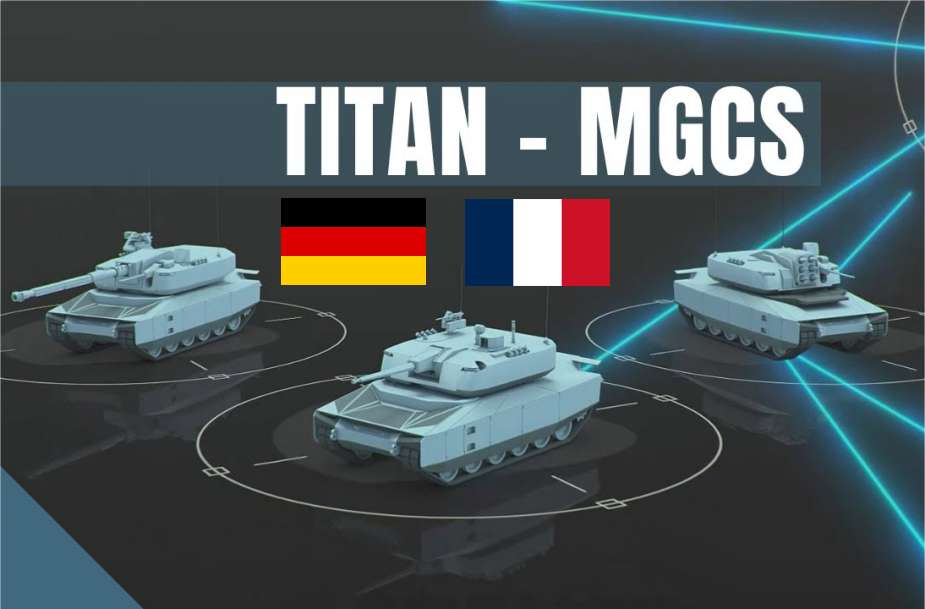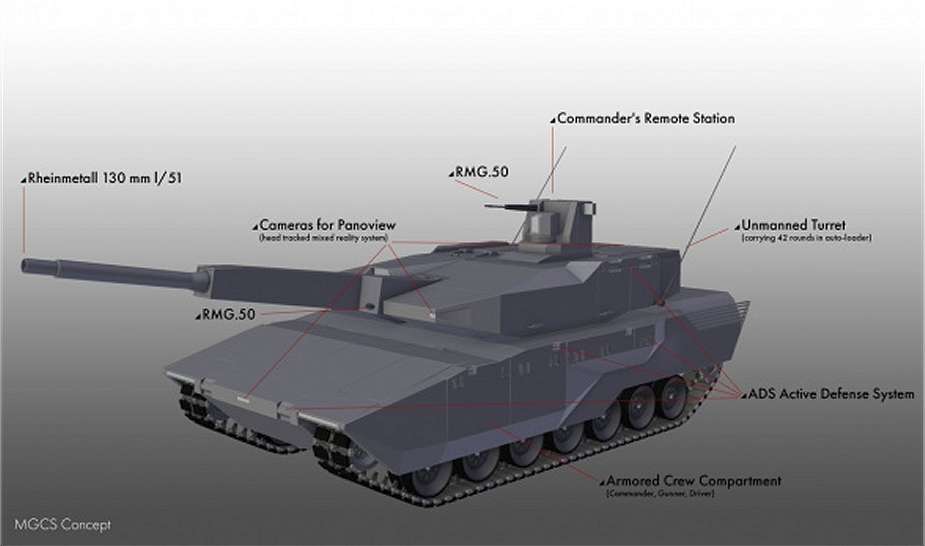Breaking news
France and Germany Agree to Develop New MGCS Tank to Replace Leopard & Leclerc MBTs.
In a landmark defense agreement, France and Germany have paved the way for the future of military technology with a breakthrough in the development of the Main Ground Combat System (MGCS), a next-generation tank set to redefine armored warfare. The defense ministers of both nations announced on March 22, 2024, that they had finalized how to divide the tasks involved in the MGCS project, marking a significant step forward in Franco-German defense collaboration.
Follow Army Recognition on Google News at this link

France and Germany commit to a 50-50 partnership in developing the next-generation Main Battle Tank under the MGCS program, focusing on the tank platform, main gun, new weaponry, communication technology, and a combat-cloud system. (Picture source Internet)
Under the agreement, the defense companies Nexter from France, and KMW and Rheinmetall from Germany, will each spearhead the development of one-third of the program's key components. It has been assured that Nexter will manufacture 50% of the systems, maintaining the originally agreed-upon balance, with the remaining share to be divided equally between the two German firms. The first unit of this advanced combat vehicle is expected to be operational by 2035.
Highlighting the significance of this collaboration, German Defense Minister Pistorius emphasized that the MGCS will be a revolutionary model, distinct from France's Leclerc and Germany's Leopard 2 tanks, equipped with cutting-edge technological advancements. "This isn't merely an update; it's a brand-new leap in tank technology," Pistorius commented.
The minister further elaborated on the agreement's specifics, stating, "We have agreed on the distribution of all tasks for this major project as to what Germany and France will be doing. Together we have determined clear boundaries, and there will be no room for interpretation or any misunderstandings." This clarity and commitment from both nations signify a unified approach towards achieving a significant enhancement in their military capabilities.
This development is not just a milestone in Franco-German defense relations but also a strategic move to strengthen European defense autonomy. By pooling resources, expertise, and industrial capabilities, France and Germany are setting a precedent for European defense cooperation, aiming to deliver a platform that will serve the future needs of their armed forces and potentially those of other European allies.
As the MGCS project progresses towards its ambitious 2035 deadline, the defense communities in both nations and across Europe will be keenly watching. This next-generation tank promises to be a game-changer in land warfare, with its advanced capabilities and the potential to foster a new era of collaborative defense technology development on the continent.

The future European Main Battle Tank will integrate the latest generation of Artificial Intelligence (AI) technologies. (Picture source Internet)
Launched in 2017, the MGCS (Main Ground Combat System) is a landmark Franco-German armament program designed to herald a new era in armored warfare. This ambitious project aims to replace the venerable German Leopard 2 tanks and the French Leclerc tanks with a system that seamlessly integrates the latest technological advancements. Unlike traditional heavy armored vehicles, the MGCS is conceived as a sophisticated multi-platform system. It includes a main battle tank equipped with a large caliber gun and is complemented by a suite of interconnected modules: a heavily armored vehicle armed with potent anti-tank missiles, a natively robotic support vehicle boasting laser weaponry, drones, and a range of other groundbreaking armaments.
The MGCS will be the tank of the future, integrating several Artificial Intelligence (AI) technologies. The MGCS stands at the forefront of military technological innovation, incorporating AI to assist crews in intelligence gathering, planning, command, and coordination of fire. This integration of AI will facilitate swift decision-making processes at the command level. "Humans will always be in the loop, thereby remaining at the heart of decision-making processes," emphasizes Martial, the capability architect overseeing the MGCS project at the French Directorate General of Armaments (DGA).
Another defining feature of the MGCS is its reliance on advanced connectivity, facilitating real-time sharing of tactical information through an integrated combat cloud. This system ensures that the various modules (or vehicles) can process, store, and instantly share tactical data, coordinating their actions in a semi-automatic manner to maximize the effectiveness of operations against adversaries.
"The MGCS is a direct evolution of the collaborative, information-enhanced approach pioneered by the Scorpion system," states Delphine, tasked with the development of future land combat systems at the DGA. In an era marked by emerging threats such as armed drones, autonomous weaponry, and cyber attacks, the MGCS's multi-platform design aims to create a combat environment that enables forces to outmaneuver the enemy by understanding, deciding, and acting more swiftly and effectively.
In terms of combat capabilities, the MGCS will able to engage targets at a range of up to 8,000 meters, doubling the range of the current Leclerc tank. Its accompanying modules enhance assault capabilities through their sheer number, mobility, and ability to act in concert, thereby multiplying the system's offensive potential. "These modules will also create numerous challenges and elements of surprise for the enemy, thereby complicating their decision-making processes," predicts Delphine.
The MGCS ecosystem extends observation capabilities up to 10,000 meters, significantly improving target detection and anticipatory abilities.
Central to the MGCS's design is a comprehensive protection suite, including active camouflage, reinforced armor, countermeasures, and neutralization capabilities, safeguarding against both aerial and terrestrial threats. The strategic distribution of weapons and equipment across several distinct platforms mitigates mass and enhances the crew's mobility and overall protection.
These technological innovations are set to play a pivotal role in Project Titan, poised to succeed in the Scorpion initiative starting from 2040. Project Titan aims to revolutionize the decisive capabilities of the Army, pushing the boundaries of collaborative air-land combat further by incorporating joint and allied operational levels.
Defense News March 2024























